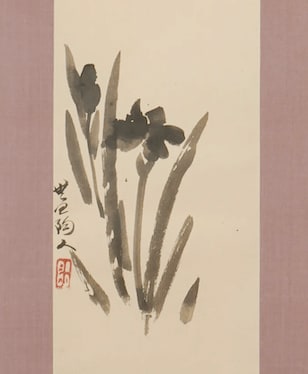Arakawa Toyozo 荒川豊蔵
H33 1/8 × W17 1/4 in.
H84.0 × W43.6 cm
Mount:
H61 1/2 × W13 1/2 in.
H156.2 × W34.2 cm
Further images
It bears the artist signature 無田陶人 Muta Tojin*
*Note: Arakawa Toyozo had begun using an alternative "Literati" or artist name 無田陶人 Muta Tojin after 1972.
In Japan, the iris has long been cherished as a symbol of wisdom and virtue, with references to it appearing in Japanese literature and art as early as the 12th century. A notable example is found in episode 7 of The Tale of Ise (Ise Monogatari). In this episode, the protagonist Ariwara Narihira is forced into exile away from the capital. Ariwara pauses at Yatsuhashi bridge, with his companions. Inspired by the sight of irises along the stream, he composes a nostalgic love poem: The first syllable of each line in the poem spells out the Japanese word for irises (Kakitsubata):
Karagoromo
kitsutsu narenishi
tsuma shi areba
harubaru kinuru
tabi o shi zo omou
I wear robes with well-worn hems,
Reminding me of my dear wife
I fondly think of always,
So as my sojourn stretches on
Ever farther from home,
Sadness fills my thoughts.
—Translation by John T. Carpenter, courtesy of the Metropolitan Museum of Art.







